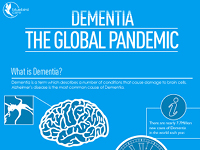According to the CDC, Parkinson’s disease (PD) is the second most common neurodegenerative disease, following Schizophrenia.1 In the United States, more than 60,000 people are diagnosed each year, with the elderly population being the most affected.2 This movement disorder may complicate basic daily activities, if not diagnosed or treated properly. With the current advances in the treatment of PD, it is possible for patients to achieve normal or near-normal life expectancies. The first step towards attaining quality of life with PD, or providing support to a loved one with PD, relies on understanding the disease and its symptoms.
What is Parkinson’s Disease?
PD is a progressive, neurodegenerative disorder that primarily affects movement. The only definite risk factor is old age, although some evidence indicates that PD is caused by a combination of other risk factors.3 Researchers have identified a handful of genetic mutations (ATP13A2, GBA, PRKN) that greatly increase the risk of PD. In addition, environmental factors, such as exposure to pesticides and heavy metals, may also have a role in the progression of PD.3,4
While the true cause of PD is unknown, there is a common biochemical abnormality found in patients – dopamine loss in an area of the midbrain known as the substantia nigra.2 An increased rate of destruction of dopamine-producing neurons in this area of the brain leads to low levels of dopamine, which is critical for initiating and regulating movement. Therefore, at a loss of about 50% to 80% of dopamine-producing neurons, the cardinal symptoms of PD become evident.4
4 Cardinal Signs of Parkinson’s Disease
Bradykinesia
The clinical diagnosis of PD is based on the presence of bradykinesia, and one of the other three cardinal symptoms. Bradykinesia refers to slowness of movement, or inability to move the body swiftly on command.2,4 Thus, automatic actions that are normally performed without conscious effort, such as blinking, become reduced in patients with bradykinesia. It can also present as a difficulty in initiating movement, like standing up or turning over in bed. In PD, bradykinesia may present in the following ways:
- Lack of spontaneous activity, such as reduced arm swinging when walking
- Freezing or periods of immobility
- Soft or monotonous speech
- Difficulty with tasks that are repetitive in nature, such as tapping fingers
- Difficulty in performing everyday tasks, such as brushing their teeth and buttoning their shirts
Resting Tremor
Resting tremors are only one subtype of twenty tremor classifications. Symptoms for this specific tremor include a rhythmic, involuntary shaking of hands at rest, which disappear during voluntary movement.5 The most frequent indicator of a resting tremor is a pill-rolling motion, involving the thumb and index finger. Less commonly, these tremors may also affect the ankles, jaw, and lips. Initially, resting tremors may appear on one side of the body, but it may spread as the disease progresses. Although these tremors are a common symptom of PD, not all patients present resting tremors. Only two-thirds of patients with PD have tremors on diagnosis.4
Muscular Rigidity
Muscle rigidity is characterized by stiff muscle tone and an increased resistance to movement, beyond what would result from arthritis or normal aging.6 Due to an inability to stretch and relax muscles, it is experienced as “tightness” in the limbs. This may result in pain and discomfort when trying to perform everyday tasks. Muscle rigidity is also often manifested in a “cogwheel” rigidity with ratcheting, catch-release type movements. Facial muscles are also affected, resulting in a decreased range of facial expressions known as “masking”.2,4 Consequences of muscle rigidity include:
- Pain and muscle cramps
- Poor mobility and limited range in movement
- Fatigue
Postural Instability
Postural Instability is the inability to maintain an upright posture. It is most commonly seen in the advanced stages of PD. Patients may have tendencies for a propulsive gait, which is when the person walks with a stooped-forward position. This leads to an impairment in balance and increased risk of falls, since patients have difficulty in halting their steps while in motion. Postural instability is the most disabling problem in PD, and is the least responsive to pharmacotherapy.4
Treatment Options of Parkinson’s Disease
Currently, there is no known cure for PD. Available treatments control symptoms and offer an improved quality of life, but ultimately, disease progression is inevitable. Destruction of the dopamine-producing neurons will continue at a rate of 15% per decade, regardless of treatment.4 However, a wide range of drugs are able to compensate for the dopamine deficit and therefore, alleviate the symptoms of PD. For early stages of PD, it may be possible that no treatment is necessary, as symptoms are usually mild. For later stages, the most effective treatment is Levodopa, a drug that converts into dopamine in the brain.4 It is important to note that your doctor will find the medication that is best suited for you. If diagnosed with PD, make sure to regularly attend your appointments for therapy evaluations.
References
- Gwinn, M., MD (2013, January 29). Genetics, coffee consumption, and Parkinson’s disease. Retrieved September 04, 2020, from https://www.cdc.gov/genomics/hugenet/casestudy/parkinson/parkcoffee_view.htm
- Elkouzi, A., MD (Ed.). (n.d.). Understanding Parkinson’s. Retrieved September 03, 2020, from https://www.parkinson.org/understanding-parkinsons
- Parkinson’s disease causes. (n.d.). Retrieved September 03, 2020, from https://www.michaeljfox.org/causes
- Dashtipour, K. (2019). Chapter 59: Parkinson Disease. In 917632732 721077200 J. T. DiPiro & 917632733 721077200 J. J. Chen (Authors), Pharmacotherapy: A pathophysiologic approach(10th ed.). New York: McGraw Hill Medical.
- National Institute of Neurological Disorder and Stroke. Tremor Fact Sheet. (2017, May). Retrieved September 05, 2020, from https://www.ninds.nih.gov/Disorders/Patient-Caregiver-Education/Fact-Sheets/Tremor-Fact-Sheet
- European Parkinson’s Disease Association. (2016, February). Rigidity. Retrieved September 05, 2020, from https://www.epda.eu.com/about-parkinsons/symptoms/motor-symptoms/rigidity/
Author
Ashley Guzmán Melero, B.S. in Biomedical Sciences, PharmD. Candidate







